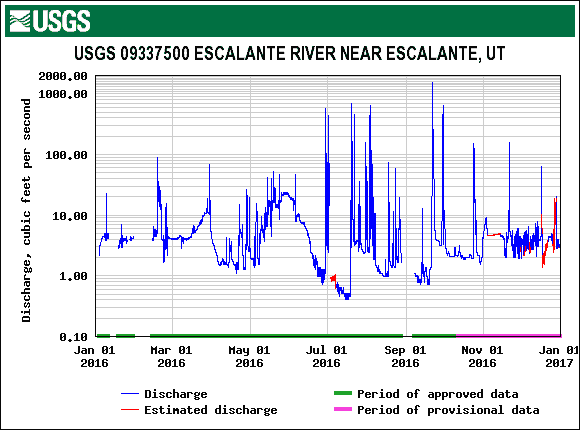Introduction
For many packrafters, backpackers, and canyoneers, the Escalante canyon of southern Utah provides a variety of opportunities.

Our party of four combined packrafting, backpacking, and canyoneering into a week-long adventure to Escalante canyon during early May. Our hopes were high that the river would have a sufficient flow of water for packrafting. Whether the Escalante was flowing or not, we were going to figure out how to make it all happen!

The Escalante River was first floated by Georgie White and Harry Aleson on May 24, 1948. These words by Harry are very appropriate for a typical river run down the Escalante:
“Forty feet after we started, in a narrow, shallow pool, we were aground.”
Escalante River flows average 10-100 cfs during spring runoff (April and May), which are reasonable flows for experienced packrafters and kayakers. Flows less than 10 cfs generally result in a bit of bottom-bumping and portaging over gravel bars. Brief spikes up to 1000 cfs or more (which can be quite dangerous) occur throughout the summer as a result of summer thunderstorms that can increase river levels by several feet for a few hours (or less) at a time.
This graph shows the range of flows on the Escalante during the most recent full calendar year (source: USGS). This gives you an idea of the extreme variation of flows – more than three orders of magnitude.

The flow for our trip averaged about 1.5 cfs.
Generally, we were on the river when the gauge read about 1.2 cfs. There was a brief spike of up to 10 cfs while we were there, but it probably went by while we were asleep. The best way to describe the flow of the river was “extremely low”! Still, we had a great experience packrafting the Escalante, while canyoneering and hiking some of the river’s side canyons.
This essay includes the details of our trip plan, some photos, and summarizes a few of the lessons we learned along the way.
Trip Notes
- Our Plan:
- Day 1 – Hike from the Neon Canyon Trailhead to the confluence of Fence Canyon with the Escalante River (5 mi / 8 km)
- Day 2-3 – Canyoneering in Neon and Choprock Canyons (from a basecamp at Fence Canyon)
- Day 4-6 – Packrafting from Fence Canyon to Coyote Gulch, maybe with some ad-hoc canyoneering (39 mi / 63 km)
- Day 7 – Hike from Coyote Gulch to the Hole-in-the-Rock Road via Crack in the Wall (3 mi / 5 km)
- Our Experience
- All of us had backpacking experience, three of us had canyoneering experience, and none of us had packrafting experience.
This interactive map (courtesy of CalTopo) highlights the key elements (mileages, camps, notable canyons) of our trip:
Trip Report
Member Exclusive
A Premium or Unlimited Membership* is required to view the rest of this article.
* A Basic Membership is required to view Member Q&A events




Home › Forums › Escalante Packrafting and Technical Canyoneering